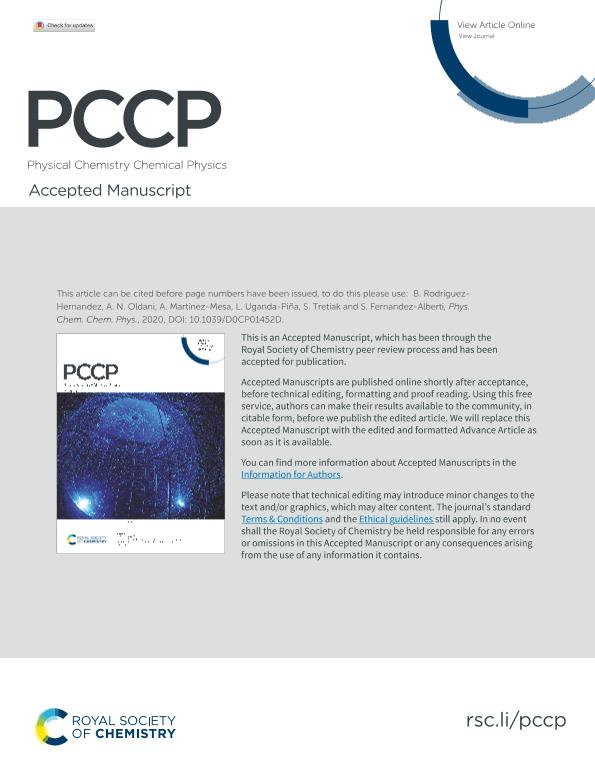Mostrar el registro sencillo del ítem
dc.contributor.author
Rodríguez Hernández, Beatriz

dc.contributor.author
Oldani, Andres Nicolas

dc.contributor.author
Martinez Mesa, Aliezer

dc.contributor.author
Uranga Pina, Llinersy
dc.contributor.author
Tretiak, Sergei

dc.contributor.author
Fernández Alberti, Sebastián

dc.date.available
2023-08-04T20:07:27Z
dc.date.issued
2020-07
dc.identifier.citation
Rodríguez Hernández, Beatriz; Oldani, Andres Nicolas; Martinez Mesa, Aliezer; Uranga Pina, Llinersy; Tretiak, Sergei; et al.; Photoexcited energy relaxation and vibronic couplings in π-conjugated carbon nanorings; Royal Society of Chemistry; Physical Chemistry Chemical Physics; 22; 27; 7-2020; 15321-15332
dc.identifier.issn
1463-9076
dc.identifier.uri
http://hdl.handle.net/11336/207075
dc.description.abstract
Conjugated carbon nanorings exhibit unique photophysical properties that, combined with their tunable sizes and conformations, make them suitable for a variety of practical applications. These properties are intimately associated to their strained, bent and sterically hindered cyclic structures. Herein we perform a comparative analysis of the photoinduced dynamics in carbon nanorings composed of nine phenyl units([9]CPP) and nine naphthyl units ([9]CN) respectively. The sterically demanding naphthyl units lead to large dihedral angles between neighboring units. Nevertheless, the ultrafast electronic and vibrational energy relaxation and redistribution is found to be similar for both systems. We observe that vibronic couplings, introduced by nonadiabatic energy transfer between electronic excited states, ensure the intramolecular vibrational energy redistribution through specific vibrational modes. The comparative impact of the internal conversion process on the exciton spatial localization and intra-ring migration indicates that naphthyl units in [9]CN achieve more efficient but less dynamical self-trapping compared to that of phenyl units in [9]CPP. That is, during the photoinduced process, the exciton in [9]CN is more static and localized than the exciton in [9]CPP. The internal conversion processes take place through a specific set of middle- to high-frequency normal modes, which directly influence the spatial exciton redistribution during the internal conversion, self-trapping and intra-ring migration.
dc.format
application/pdf
dc.language.iso
eng
dc.publisher
Royal Society of Chemistry

dc.rights
info:eu-repo/semantics/openAccess
dc.rights.uri
https://creativecommons.org/licenses/by-nc-sa/2.5/ar/
dc.subject
Nonadiabatic molecular dynamics
dc.subject
Excited states
dc.subject
Nanorings
dc.subject.classification
Físico-Química, Ciencia de los Polímeros, Electroquímica

dc.subject.classification
Ciencias Químicas

dc.subject.classification
CIENCIAS NATURALES Y EXACTAS

dc.title
Photoexcited energy relaxation and vibronic couplings in π-conjugated carbon nanorings
dc.type
info:eu-repo/semantics/article
dc.type
info:ar-repo/semantics/artículo
dc.type
info:eu-repo/semantics/publishedVersion
dc.date.updated
2023-08-04T12:20:03Z
dc.journal.volume
22
dc.journal.number
27
dc.journal.pagination
15321-15332
dc.journal.pais
Reino Unido

dc.journal.ciudad
Cambrigde
dc.description.fil
Fil: Rodríguez Hernández, Beatriz. Consejo Nacional de Investigaciones Científicas y Técnicas; Argentina. Universidad Nacional de Quilmes. Departamento de Ciencia y Tecnología; Argentina
dc.description.fil
Fil: Oldani, Andres Nicolas. Consejo Nacional de Investigaciones Científicas y Técnicas; Argentina. Universidad Nacional de Quilmes. Departamento de Ciencia y Tecnología; Argentina
dc.description.fil
Fil: Martinez Mesa, Aliezer. Consejo Nacional de Investigaciones Científicas y Técnicas; Argentina. Universidad Nacional de Quilmes. Departamento de Ciencia y Tecnología; Argentina
dc.description.fil
Fil: Uranga Pina, Llinersy. Universidad Nacional de Quilmes. Departamento de Ciencia y Tecnología; Argentina
dc.description.fil
Fil: Tretiak, Sergei. Los Alamos National Laboratory; Estados Unidos
dc.description.fil
Fil: Fernández Alberti, Sebastián. Consejo Nacional de Investigaciones Científicas y Técnicas; Argentina. Universidad Nacional de Quilmes. Departamento de Ciencia y Tecnología; Argentina
dc.journal.title
Physical Chemistry Chemical Physics

dc.relation.alternativeid
info:eu-repo/semantics/altIdentifier/url/https://pubs.rsc.org/en/content/articlelanding/2020/cp/d0cp01452d
dc.relation.alternativeid
info:eu-repo/semantics/altIdentifier/doi/https://doi.org/10.1039/D0CP01452D
Archivos asociados
